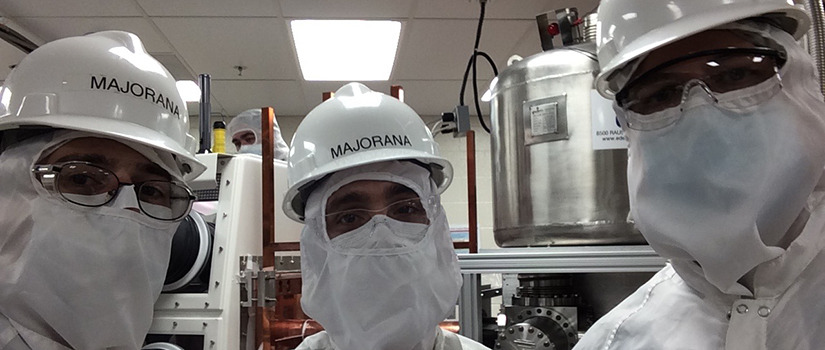Physicists explore origins of universe, discover breakthroughs along the way
Searching for clues on how the universe began took a team of University of South Carolina physicists more than a mile underground.
Vincente Guiseppe, Frank Avignone and David Tedeschi, all of the College of Arts and Sciences’ Department of Physics and Astronomy, are part of an international project searching for a phenomenon in atoms that may further explain what we see after the Big Bang and why matter exists today.
"We owe it to ourselves to understand the world around us, and this is an important piece of what we see around us—the fact that matter does exist and it created the universe as we know it,” says Guiseppe, who has been part of the U.S. Department of Energy’s MAJORANA Demonstrator experiment for almost 10 years.
The nearly decade-long project achieved a key accomplishment with findings published in “Physical Review Letters” in March. The international team of 129 researchers from 27 institutions showed they can shield detectors from background radioactivity noise, which paves the way for larger experiments in the future. The original idea began more than 20 years ago when Avignone and collaborators first conceived of the experiment, which builds off Avignone’s previous work.
By all scientific reasoning and theories, there should only be energy—no matter to form planets and life—in our universe. That’s because matter and antimatter is expected to balance each other out. Yet a speck of matter formed, Guiseppe explains when describing the universe’s beginnings. He and other scientists point to a subatomic particle called the neutrino as a likely candidate for tipping the scales.
Why do scientists need to travel underground to better understand the universe’s origins more the 13 billion years ago?
There, they can better study the nature of neutrinos free from outside influence like natural radioactivity, dust and fingerprints. This is why the experiment is conducted in a cleanroom at the Sanford Underground Research Facility, a former gold mine in Lead, South Dakota. To further protect the experiment from cosmic rays and natural radioactivity, Guiseppe oversaw construction of a multi-layered shield made of more than 4,000 lead bricks surrounding a copper enclosure.
The structure protects coffee mug-sized geranium detectors designed to identify the much sought-after occurrence called neutrino-less double beta decay. Avignone’s role was to develop a process for producing the highly pure detector material enriched to contain the necessary isotope. Tedeschi leads the data production and ensures that quality data is collected for the experiment, which has been up and running for a few years.
Graduate student Clint Wiseman also has been closely involved with the project throughout his studies at Carolina, spending time in the cleanroom in South Dakota. He expects to complete his doctorate this year with a dissertation focusing on data from the experiment.
In a 2015 report of the U.S. Nuclear Science Advisory Committee to the Department of Energy and the National Science Foundation, a U.S.-led ton-scale experiment to detect neutrinoless double-beta decay was deemed a top priority of the nuclear physics community. Nearly a dozen experiments have sought this phenomenon, and as many future experiments have been proposed.
Breakthroughs achieved during the MAJORANA’s construction process are another benefit from the project.
“We’re after this neutrino process that we think could happen, but what’s the day to day stuff we also learn?” says Guiseppe. “As part of the work, we’ve produced this process where we’ve made copper cleaner than anybody else ever has. It’s an advance that now people can use. We are all motivated by the science, but we also know there are a lot of cool advances along the way.”
Learn more about the MAJORANA Demonstrator and see photos from the Oak Ridge National Laboratory.
